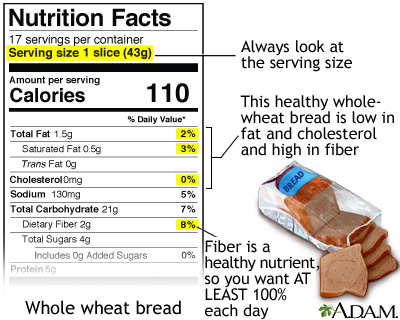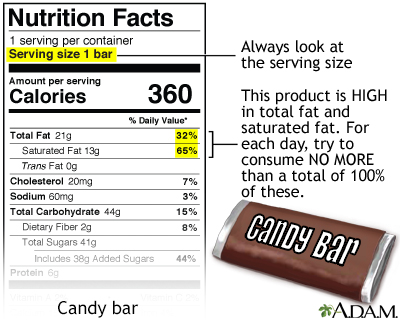How to read food labels
Food labels give you information about the calories, number of servings, and nutrient content of packaged foods. Reading the labels can help you make healthy choices when you shop and plan meals.
About Food Labels
Food labels tell you the nutrition facts about the foods you buy. Use the food labels to help you choose healthier foods.
What to Look for
Always check the serving size first. All the information on the label is based on the serving size. Many packages contain more than 1 serving.
For example, the serving size for spaghetti is most often 2 ounces (56 grams) uncooked, or 1 cup (140 grams) cooked. If you eat 2 cups (280 grams) at a meal, you are eating 2 servings. That is 2 times the amount of the calories, fats, and other nutrients listed on the label.
Calorie information tells you the number of calories in 1 serving. Adjust the number of calories if you eat smaller or larger portions. This number helps determine how foods affect your weight.
The total carbs (carbohydrates) are listed in bold letters to stand out and are measured in grams (g). Sugar, starch, and dietary fiber make up the total carbs on the label. Sugar is listed separately. All of these carbs except fiber can raise your blood sugar.
If you have diabetes and count carbs to calculate your insulin doses, the American Diabetes Association recommends that you use the total carbs to calculate your insulin doses. Some people may get better results by subtracting some or all of the dietary fiber grams from the carb count.
Diabetes
Diabetes is a long-term (chronic) disease in which the body cannot regulate the amount of sugar in the blood.

Dietary fiber is listed just below total carbs. Buy foods with at least 3 to 4 grams of fiber per serving. Whole-grain breads, fruits and vegetables, and beans and legumes are high in fiber.

Food label guide for whole wheat bread
Whole grains, like the kind found in whole wheat bread, contain fiber and antioxidants such as Vitamin E and selenium, iron, magnesium, zinc and B vitamins. Fiber is a very beneficial nutrient that is found in whole grain products. Fiber helps to reduce the risk for some chronic diseases such as constipation, hemorrhoids and diverticulosis. Fiber is also linked to the prevention of some cancers like colon cancer. Fiber may help reduce the risk of heart disease and diabetes.
Check the total fat in 1 serving. Pay special attention to the amount of saturated fat in 1 serving.
Choose foods that are low in saturated fat. For example, drink skim or 1% milk instead of 2% or whole milk. Skim milk has only a trace of saturated fat. Whole milk has 5 grams of this fat per serving.
Saturated fat
Exercise is an important part of managing your diabetes. If you are obese or overweight, exercise can help you manage your weight.

Fish is much lower in saturated fat than beef. Three ounces (84 grams) of fish has less than 1 gram of saturated fat. Three ounces (84 grams) of hamburger has more than 5 grams.
If a food has less than 0.5 grams of saturated fat in the serving size on the label, the food maker can say it contains no saturated fat. Remember this if you eat more than 1 serving.
You should also pay attention to trans fats on any food label. These fats raise bad cholesterol and lower your good cholesterol.
These fats are mostly found in snack foods and desserts. Many fast food restaurants use trans fats for frying.
If a food has these fats, the amount will be listed on the label under total fat. They are measured in grams. Look for foods that have no trans fats or are low in them (1 gram or less).

Food Label Guide for Candy
Saturated fats are found in animal products such as butter, cheese, whole milk, ice cream, cream, and fatty meats. They are also found in some vegetable oils -- coconut, palm, and palm kernel oils. Eating too much saturated fat is one of the major risk factors for heart disease. A diet high in saturated fat causes a soft, waxy substance called cholesterol to build up in the arteries. Too much fat also increases the risk of heart disease because of its high calorie content, which increases the chance of becoming obese (another risk factor for heart disease and some types of cancer).
Sodium is the most important ingredient of salt. This number is important for people who are trying to get less salt in their diet. If a label says that a food has 100 mg of sodium, this means it has about 250 mg of salt. You should eat no more than 2,300 mg of sodium per day. This is the amount of sodium that is in 1 measuring teaspoon of table salt. Ask your health care provider if you should have even less.
The % daily value is included on the label as a guide.
The percentage for each item on the label is based on eating 2,000 calories a day. Your goals will be different if you eat more or fewer calories a day. A dietitian or your provider can help you set your own nutrition goals.
Reviewed By
Stefania Manetti, RD/N, CDCES, RYT200, My Vita Sana LLC - Nourish and heal through food, San Jose, CA. Review provided by VeriMed Healthcare Network. Also reviewed by David C. Dugdale, MD, Medical Director, Brenda Conaway, Editorial Director, and the A.D.A.M. Editorial team.
American Diabetes Association. Diabetes and food: reading food labels. diabetes.org/food-nutrition/reading-food-labels/making-sense-food-labels. Accessed August 6, 2024.
Arnett DK, Blumenthal RS, Albert MA, Buroker AB, et al. 2019 ACC/AHA guideline on the primary prevention of cardiovascular disease: a report of the American College of Cardiology/American Heart Association Task Force on Clinical Practice Guidelines. Circulation. 2019;140(11):e596-e646. PMID: 30879355 pubmed.ncbi.nlm.nih.gov/30879355/.
Bakris GL, Sorrentino MJ. Systemic hypertension: mechanisms, diagnosis, and treatment. In: Libby P, Bonow RO, Mann DL, Tomaselli GF, Bhatt DL, Solomon SD, eds. Braunwald's Heart Disease: A Textbook of Cardiovascular Medicine. 12th ed. Philadelphia, PA: Elsevier; 2022:chap 26.
Hensrud DD. Diet and nutrition. In: Goldman L, Cooney KA, eds. Goldman-Cecil Medicine. 27th ed. Philadelphia, PA: Elsevier; 2024:chap 13.
US Department of Agriculture and US Department of Health and Human Services. Dietary Guidelines for Americans, 2020-2025. 9th ed. www.dietaryguidelines.gov/sites/default/files/2020-12/Dietary_Guidelines_for_Americans_2020-2025.pdf. Updated December 2020. Accessed September 23, 2024.
 All rights reserved.
All rights reserved.